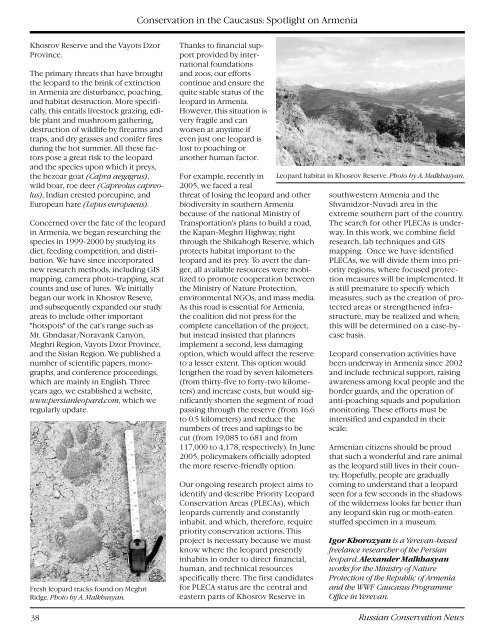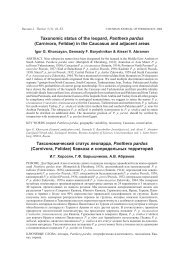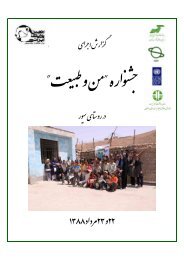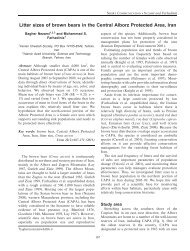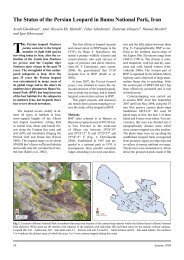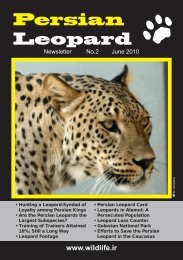Research and conservation of the Persian leopard in Armenia
Research and conservation of the Persian leopard in Armenia
Research and conservation of the Persian leopard in Armenia
You also want an ePaper? Increase the reach of your titles
YUMPU automatically turns print PDFs into web optimized ePapers that Google loves.
Conservation <strong>in</strong> <strong>the</strong> Caucasus: Spotlight on <strong>Armenia</strong><br />
Khosrov Reserve <strong>and</strong> <strong>the</strong> Vayots Dzor<br />
Prov<strong>in</strong>ce.<br />
The primary threats that have brought<br />
<strong>the</strong> <strong>leopard</strong> to <strong>the</strong> br<strong>in</strong>k <strong>of</strong> ext<strong>in</strong>ction<br />
<strong>in</strong> <strong>Armenia</strong> are disturbance, poach<strong>in</strong>g,<br />
<strong>and</strong> habitat destruction. More specifically,<br />
this entails livestock graz<strong>in</strong>g, edible<br />
plant <strong>and</strong> mushroom ga<strong>the</strong>r<strong>in</strong>g,<br />
destruction <strong>of</strong> wildlife by firearms <strong>and</strong><br />
traps, <strong>and</strong> dry grasses <strong>and</strong> conifer fires<br />
dur<strong>in</strong>g <strong>the</strong> hot summer. All <strong>the</strong>se factors<br />
pose a great risk to <strong>the</strong> <strong>leopard</strong><br />
<strong>and</strong> <strong>the</strong> species upon which it preys,<br />
<strong>the</strong> bezoar goat (Capra aegagrus),<br />
wild boar, roe deer (Capreolus capreolus),<br />
Indian crested porcup<strong>in</strong>e, <strong>and</strong><br />
European hare (Lepus europaeus).<br />
Concerned over <strong>the</strong> fate <strong>of</strong> <strong>the</strong> <strong>leopard</strong><br />
<strong>in</strong> <strong>Armenia</strong>, we began research<strong>in</strong>g <strong>the</strong><br />
species <strong>in</strong> 1999-2000 by study<strong>in</strong>g its<br />
diet, feed<strong>in</strong>g competition, <strong>and</strong> distribution.<br />
We have s<strong>in</strong>ce <strong>in</strong>corporated<br />
new research methods, <strong>in</strong>clud<strong>in</strong>g GIS<br />
mapp<strong>in</strong>g, camera photo-trapp<strong>in</strong>g, scat<br />
counts <strong>and</strong> use <strong>of</strong> lures. We <strong>in</strong>itially<br />
began our work <strong>in</strong> Khosrov Reseve,<br />
<strong>and</strong> subsequently exp<strong>and</strong>ed our study<br />
areas to <strong>in</strong>clude o<strong>the</strong>r important<br />
"hotspots" <strong>of</strong> <strong>the</strong> cat's range such as<br />
Mt. Gbndasar/Noravank Canyon,<br />
Meghri Region, Vayots Dzor Prov<strong>in</strong>ce,<br />
<strong>and</strong> <strong>the</strong> Sisian Region. We published a<br />
number <strong>of</strong> scientific papers, monographs,<br />
<strong>and</strong> conference proceed<strong>in</strong>gs,<br />
which are ma<strong>in</strong>ly <strong>in</strong> English. Three<br />
years ago, we established a website,<br />
www.persian<strong>leopard</strong>.com, which we<br />
regularly update.<br />
Fresh <strong>leopard</strong> tracks found on Meghri<br />
Ridge. Photo by A. Malkhasyan.<br />
Thanks to f<strong>in</strong>ancial support<br />
provided by <strong>in</strong>ternational<br />
foundations<br />
<strong>and</strong> zoos, our efforts<br />
cont<strong>in</strong>ue <strong>and</strong> ensure <strong>the</strong><br />
quite stable status <strong>of</strong> <strong>the</strong><br />
<strong>leopard</strong> <strong>in</strong> <strong>Armenia</strong>.<br />
However, this situation is<br />
very fragile <strong>and</strong> can<br />
worsen at anytime if<br />
even just one <strong>leopard</strong> is<br />
lost to poach<strong>in</strong>g or<br />
ano<strong>the</strong>r human factor.<br />
For example, recently <strong>in</strong><br />
2005, we faced a real<br />
threat <strong>of</strong> los<strong>in</strong>g <strong>the</strong> <strong>leopard</strong> <strong>and</strong> o<strong>the</strong>r<br />
biodiversity <strong>in</strong> sou<strong>the</strong>rn <strong>Armenia</strong><br />
because <strong>of</strong> <strong>the</strong> national M<strong>in</strong>istry <strong>of</strong><br />
Transportation's plans to build a road,<br />
<strong>the</strong> Kapan-Meghri Highway, right<br />
through <strong>the</strong> Shikahogh Reserve, which<br />
protects habitat important to <strong>the</strong><br />
<strong>leopard</strong> <strong>and</strong> its prey. To avert <strong>the</strong> danger,<br />
all available resources were mobilized<br />
to promote cooperation between<br />
<strong>the</strong> M<strong>in</strong>istry <strong>of</strong> Nature Protection,<br />
environmental NGOs, <strong>and</strong> mass media.<br />
As this road is essential for <strong>Armenia</strong>,<br />
<strong>the</strong> coalition did not press for <strong>the</strong><br />
complete cancellation <strong>of</strong> <strong>the</strong> project,<br />
but <strong>in</strong>stead <strong>in</strong>sisted that planners<br />
implement a second, less damag<strong>in</strong>g<br />
option, which would affect <strong>the</strong> reserve<br />
to a lesser extent. This option would<br />
leng<strong>the</strong>n <strong>the</strong> road by seven kilometers<br />
(from thirty-five to forty-two kilometers)<br />
<strong>and</strong> <strong>in</strong>crease costs, but would significantly<br />
shorten <strong>the</strong> segment <strong>of</strong> road<br />
pass<strong>in</strong>g through <strong>the</strong> reserve (from 16.6<br />
to 0.5 kilometers) <strong>and</strong> reduce <strong>the</strong><br />
numbers <strong>of</strong> trees <strong>and</strong> sapl<strong>in</strong>gs to be<br />
cut (from 19,085 to 681 <strong>and</strong> from<br />
117,000 to 4,178, respectively). In June<br />
2005, policymakers <strong>of</strong>ficially adopted<br />
<strong>the</strong> more reserve-friendly option.<br />
Our ongo<strong>in</strong>g research project aims to<br />
identify <strong>and</strong> describe Priority Leopard<br />
Conservation Areas (PLECAs), which<br />
<strong>leopard</strong>s currently <strong>and</strong> constantly<br />
<strong>in</strong>habit, <strong>and</strong> which, <strong>the</strong>refore, require<br />
priority <strong>conservation</strong> actions. This<br />
project is necessary because we must<br />
know where <strong>the</strong> <strong>leopard</strong> presently<br />
<strong>in</strong>habits <strong>in</strong> order to direct f<strong>in</strong>ancial,<br />
human, <strong>and</strong> technical resources<br />
specifically <strong>the</strong>re. The first c<strong>and</strong>idates<br />
for PLECA status are <strong>the</strong> central <strong>and</strong><br />
eastern parts <strong>of</strong> Khosrov Reserve <strong>in</strong><br />
Leopard habitat <strong>in</strong> Khosrov Reserve. Photo by A. Malkhasyan.<br />
southwestern <strong>Armenia</strong> <strong>and</strong> <strong>the</strong><br />
Shvanidzor-Nuvadi area <strong>in</strong> <strong>the</strong><br />
extreme sou<strong>the</strong>rn part <strong>of</strong> <strong>the</strong> country.<br />
The search for o<strong>the</strong>r PLECAs is underway.<br />
In this work, we comb<strong>in</strong>e field<br />
research, lab techniques <strong>and</strong> GIS<br />
mapp<strong>in</strong>g. Once we have identified<br />
PLECAs, we will divide <strong>the</strong>m <strong>in</strong>to priority<br />
regions, where focused protection<br />
measures will be implemented. It<br />
is still premature to specify which<br />
measures, such as <strong>the</strong> creation <strong>of</strong> protected<br />
areas or streng<strong>the</strong>ned <strong>in</strong>frastructure,<br />
may be realized <strong>and</strong> when;<br />
this will be determ<strong>in</strong>ed on a case-bycase<br />
basis.<br />
Leopard <strong>conservation</strong> activities have<br />
been underway <strong>in</strong> <strong>Armenia</strong> s<strong>in</strong>ce 2002<br />
<strong>and</strong> <strong>in</strong>clude technical support, rais<strong>in</strong>g<br />
awareness among local people <strong>and</strong> <strong>the</strong><br />
border guards, <strong>and</strong> <strong>the</strong> operation <strong>of</strong><br />
anti-poach<strong>in</strong>g squads <strong>and</strong> population<br />
monitor<strong>in</strong>g. These efforts must be<br />
<strong>in</strong>tensified <strong>and</strong> exp<strong>and</strong>ed <strong>in</strong> <strong>the</strong>ir<br />
scale.<br />
<strong>Armenia</strong>n citizens should be proud<br />
that such a wonderful <strong>and</strong> rare animal<br />
as <strong>the</strong> <strong>leopard</strong> still lives <strong>in</strong> <strong>the</strong>ir country.<br />
Hopefully, people are gradually<br />
com<strong>in</strong>g to underst<strong>and</strong> that a <strong>leopard</strong><br />
seen for a few seconds <strong>in</strong> <strong>the</strong> shadows<br />
<strong>of</strong> <strong>the</strong> wilderness looks far better than<br />
any <strong>leopard</strong> sk<strong>in</strong> rug or moth-eaten<br />
stuffed specimen <strong>in</strong> a museum.<br />
Igor Khorozyan is a Yerevan-based<br />
freelance researcher <strong>of</strong> <strong>the</strong> <strong>Persian</strong><br />
<strong>leopard</strong>. Alex<strong>and</strong>er Malkhasyan<br />
works for <strong>the</strong> M<strong>in</strong>istry <strong>of</strong> Nature<br />
Protection <strong>of</strong> <strong>the</strong> Republic <strong>of</strong> <strong>Armenia</strong><br />
<strong>and</strong> <strong>the</strong> WWF Caucasus Programme<br />
Office <strong>in</strong> Yerevan.<br />
38 Russian Conservation News


